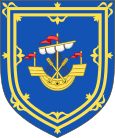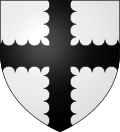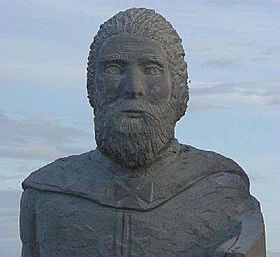Henry I Sinclair, Earl of Orkney facts for kids
Quick facts for kids
Henry Sinclair
|
|
|---|---|
| Earl of Orkney Baron of Roslin |
|
  
(Top) Earl of Orkney and Baron of Roslin Coats of Arms. (Bottom) Statue of Henry Sinclair at the Isle of Noss lighthouse.
|
|
| Predecessor | Earldom of Orkney: Vacant Baron of Roslin: Willliam St Clair |
| Successor | Henry II Sinclair, Earl of Orkney |
| Known for | The legend of him discovering North America 100 years before Christopher Columbus. |
| Born | c. 1345 |
| Died | c. 1400 |
| Nationality | Scottish |
| Offices | Lord High Admiral of Scotland |
| Noble family | Clan Sinclair |
Henry I Sinclair, Earl of Orkney, Lord of Roslin (around 1345 – around 1400) was a powerful Scottish and Norwegian nobleman. He was known as the Earl of Orkney, a title that covered many islands north of Scotland. He also served as the Lord High Admiral of Scotland for the Scottish King.
Henry Sinclair is most famous today because of a modern story. This story claims he explored Greenland and North America almost 100 years before Christopher Columbus. However, many historians say there is little proof for this legend.
Contents
Henry Sinclair's Life and Titles

Henry Sinclair was the son of William Sinclair, Lord of Roslin. His mother was Isabella of Strathearn. Her father, Maol Ísa, had been a Jarl (Earl) of Orkney. However, he had lost much of his land.
After his father died, Henry Sinclair became the Baron of Roslin. This title meant he owned some smaller properties in Scotland.
The title of Jarl of Orkney was not usually passed down from parent to child in Norway. But it often happened that way. After the title was empty for 18 years, three cousins wanted it. Henry Sinclair was one of them.
In 1379, King Haakon VI of Norway chose Henry Sinclair to be the new Jarl (Earl) of Orkney. In return, Henry promised to pay a fee and serve the King with 100 armed men when needed. It is not known if he ever paid the fee or sent the troops.
Henry left people behind as a promise to keep his word. But the King allowed them to return home before he died in 1380. In 1389, Henry Sinclair promised his loyalty to the new King, Eric, in Norway.
Sinclair was later called an "admiral of the seas." This refers to his role as the Lord High Admiral of Scotland. He held this position while serving the King of Scotland.
It is not clear exactly when Henry Sinclair died. Some records suggest he died around 1400. A document written by his grandson says he was "slain there cruellie by his enemiis" while defending Orkney. In 1401, the English attacked and burned some islands in Orkney. It is thought that Henry might have died fighting this invasion.
Henry Sinclair's Family
Henry I Sinclair, Earl of Orkney, married Jean Haliburton. They had several children:
- Henry II Sinclair, Earl of Orkney (around 1375–1422). He married Egidia Douglas.
- John Sinclair.
- William Sinclair.
- Elizabeth Sinclair (born 1363). She married Sir John Drummond of Cargill.
- Margaret Sinclair. She married James of Cragy.
- Marjory Sinclair. She married David Menzies.
- Bethoc Sinclair. She married William Borthwick.
Stories and Theories About Henry Sinclair
In recent years, many new stories have appeared about Henry I Sinclair and Rosslyn Chapel. These books are often called "pseudo-history" because they are not fully supported by facts.
The Story of a Trip to North America
One popular theory is that Henry Sinclair was one of the first Europeans to visit North America. This would have been long before Christopher Columbus. This idea came from a man named Johann Reinhold Forster in 1784. He thought Sinclair might be "Prince Zichmni." Zichmni was a person described in letters supposedly written by the Zeno brothers from Venice around 1400.
The Zeno brothers' letters and a map were published in the 1500s. Most historians believe these letters and the map are a hoax. This means they were made up. Also, most historians do not agree that "Zichmni" was Henry Sinclair.
Many authors have made the claim about Henry Sinclair exploring North America very popular. These authors include Frederick J. Pohl and Andrew Sinclair.
For this claim to be true, people must believe several things. They must believe the Zeno letters and map are real. They also must believe that the voyage described in the letters reached North America. And they must believe that Zichmni was Henry Sinclair. Some people also claim that carvings in Rosslyn Chapel show American plants. However, historians say these carvings might just be of common plants like wheat and strawberries.
A main problem with this theory is that there is no clear historical record of such a voyage. Unlike Columbus, if Sinclair reached America, he did not return with written proof. The physical evidence used to support the theory can also be explained in other ways.
Stories About Knights Templar Connections
Another theory linked to the Sinclair voyage is that Henry Sinclair was a Knight Templar. This theory suggests the voyage was supported by the Templars. However, the Knights Templar order was officially ended almost 50 years before Henry Sinclair was born.
Some authors suggest that the Templars found old records in Jerusalem. These records supposedly said that ancient sailors traveled to a western continent. Sinclair supposedly followed this route.
This theory also tries to explain the name Nova Scotia ("New Scotland" in Latin). It is based on a story from the 1700s. This story says some Templars escaped to Scotland after their order was shut down. They supposedly fought in the Battle of Bannockburn.
Claims also say that Rosslyn Chapel has Templar images. Andrew Sinclair believes a grave slab in the chapel is for a Templar knight. The chapel was built by Sir William St Clair. He was Henry's grandson.
However, historians like Mark Oxbrow and Karen Ralls have stated that the Sinclair family had no connection to the Knights Templar in the Middle Ages. In fact, Henry and William Sinclair even testified against the Templars in a trial in 1309. This action does not fit with any idea of them being Templar supporters or members.


